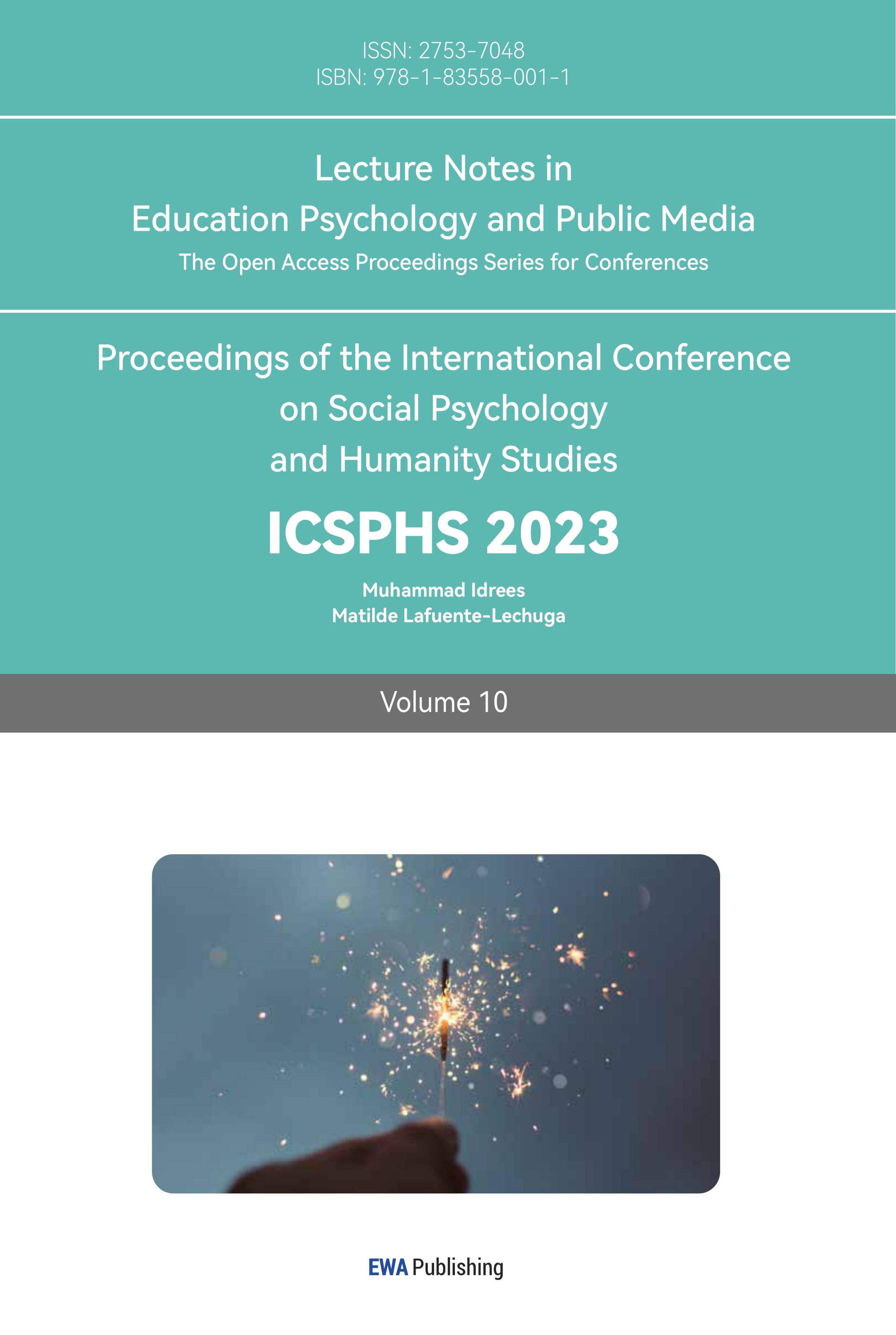References
[1]. Shaw C R, McKay H D. Juvenile delinquency and urban areas[J]. 1942.
[2]. Gove W R, Crutchfield R D. The family and juvenile delinquency[J]. Sociological Quarterly, 1982, 23(3): 301-319.
[3]. G M, Farrell M P. Parental support and control as predictors of adolescent drinking, delinquency, and related problem behaviors[J]. Journal of Marriage and the Family, 1992: 763-776.
[4]. Nisar M, Ullah S, Ali M, et al. Juvenile delinquency: The Influence of family, peer and economic factors on juvenile delinquents[J]. Applied Science Reports, 2015, 9(1): 37-48.
[5]. Matza D, Sykes G M. Juvenile delinquency and subterranean values[J]. American sociological review, 1961: 712-719.
[6]. Hindelang M J, Hirschi T, Weis J G. Correlates of delinquency: The illusion of discrepancy between self-report and official measures[J]. American sociological review, 1979: 995-1014.
[7]. Agnew R, Brezina T. Juvenile delinquency: Causes and control[M]. New York: Oxford University Press, 2012.
[8]. Johnson G M, Knight R A. Developmental antecedents of sexual coercion in juvenile sexual offenders[J]. Sexual Abuse: A Journal of Research and Treatment, 2000, 12: 165-178.
[9]. McCord J, Widom C S, Crowell N A. Juvenile Crime, Juvenile Justice. Panel on Juvenile Crime: Prevention, Treatment, and Control[M]. National Academy Press, 2101 Constitution Avenue, NW, Washington, DC, 20418, 2001.
[10]. Howell J C. Preventing and reducing juvenile delinquency: A comprehensive framework[M]. Sage, 2003.
[11]. Chyrl Jones and Jennifer Scherer, U.S Department of Justice, ojjdp.ojp.gov/publications/juvenile-arrests-2019.pdf
[12]. Mary K. Allen and Tamy Superle, Statistics Canada, Youth crime in Canada, www150.statcan.gc.ca/n1/pub/85-002-x/2016001/article/14309-eng.htm
[13]. Australia Institute of Health and Welfare, Youth justice in Australia, https://www.aic.gov.au/publications/sr
[14]. Nourollah M, Fatemeh M, Farhad J. A study of factors affecting juvenile delinquency[J]. Biomedical and Pharmacology Journal, 2015.
[15]. Justice Policy Institute, Sticker Shock 2020: The Cost of Youth Incarceration, https://justicepolicy.org/research/policy-brief-2020-sticker-shock-the-cost-of-youth-incarceration/
Cite this article
Dong,J. (2023). Analysis Of Economic Factors in Juvenile Delinquency. Lecture Notes in Education Psychology and Public Media,10,387-392.
Data availability
The datasets used and/or analyzed during the current study will be available from the authors upon reasonable request.
Disclaimer/Publisher's Note
The statements, opinions and data contained in all publications are solely those of the individual author(s) and contributor(s) and not of EWA Publishing and/or the editor(s). EWA Publishing and/or the editor(s) disclaim responsibility for any injury to people or property resulting from any ideas, methods, instructions or products referred to in the content.
About volume
Volume title: Proceedings of the International Conference on Social Psychology and Humanity Studies
© 2024 by the author(s). Licensee EWA Publishing, Oxford, UK. This article is an open access article distributed under the terms and
conditions of the Creative Commons Attribution (CC BY) license. Authors who
publish this series agree to the following terms:
1. Authors retain copyright and grant the series right of first publication with the work simultaneously licensed under a Creative Commons
Attribution License that allows others to share the work with an acknowledgment of the work's authorship and initial publication in this
series.
2. Authors are able to enter into separate, additional contractual arrangements for the non-exclusive distribution of the series's published
version of the work (e.g., post it to an institutional repository or publish it in a book), with an acknowledgment of its initial
publication in this series.
3. Authors are permitted and encouraged to post their work online (e.g., in institutional repositories or on their website) prior to and
during the submission process, as it can lead to productive exchanges, as well as earlier and greater citation of published work (See
Open access policy for details).
References
[1]. Shaw C R, McKay H D. Juvenile delinquency and urban areas[J]. 1942.
[2]. Gove W R, Crutchfield R D. The family and juvenile delinquency[J]. Sociological Quarterly, 1982, 23(3): 301-319.
[3]. G M, Farrell M P. Parental support and control as predictors of adolescent drinking, delinquency, and related problem behaviors[J]. Journal of Marriage and the Family, 1992: 763-776.
[4]. Nisar M, Ullah S, Ali M, et al. Juvenile delinquency: The Influence of family, peer and economic factors on juvenile delinquents[J]. Applied Science Reports, 2015, 9(1): 37-48.
[5]. Matza D, Sykes G M. Juvenile delinquency and subterranean values[J]. American sociological review, 1961: 712-719.
[6]. Hindelang M J, Hirschi T, Weis J G. Correlates of delinquency: The illusion of discrepancy between self-report and official measures[J]. American sociological review, 1979: 995-1014.
[7]. Agnew R, Brezina T. Juvenile delinquency: Causes and control[M]. New York: Oxford University Press, 2012.
[8]. Johnson G M, Knight R A. Developmental antecedents of sexual coercion in juvenile sexual offenders[J]. Sexual Abuse: A Journal of Research and Treatment, 2000, 12: 165-178.
[9]. McCord J, Widom C S, Crowell N A. Juvenile Crime, Juvenile Justice. Panel on Juvenile Crime: Prevention, Treatment, and Control[M]. National Academy Press, 2101 Constitution Avenue, NW, Washington, DC, 20418, 2001.
[10]. Howell J C. Preventing and reducing juvenile delinquency: A comprehensive framework[M]. Sage, 2003.
[11]. Chyrl Jones and Jennifer Scherer, U.S Department of Justice, ojjdp.ojp.gov/publications/juvenile-arrests-2019.pdf
[12]. Mary K. Allen and Tamy Superle, Statistics Canada, Youth crime in Canada, www150.statcan.gc.ca/n1/pub/85-002-x/2016001/article/14309-eng.htm
[13]. Australia Institute of Health and Welfare, Youth justice in Australia, https://www.aic.gov.au/publications/sr
[14]. Nourollah M, Fatemeh M, Farhad J. A study of factors affecting juvenile delinquency[J]. Biomedical and Pharmacology Journal, 2015.
[15]. Justice Policy Institute, Sticker Shock 2020: The Cost of Youth Incarceration, https://justicepolicy.org/research/policy-brief-2020-sticker-shock-the-cost-of-youth-incarceration/









